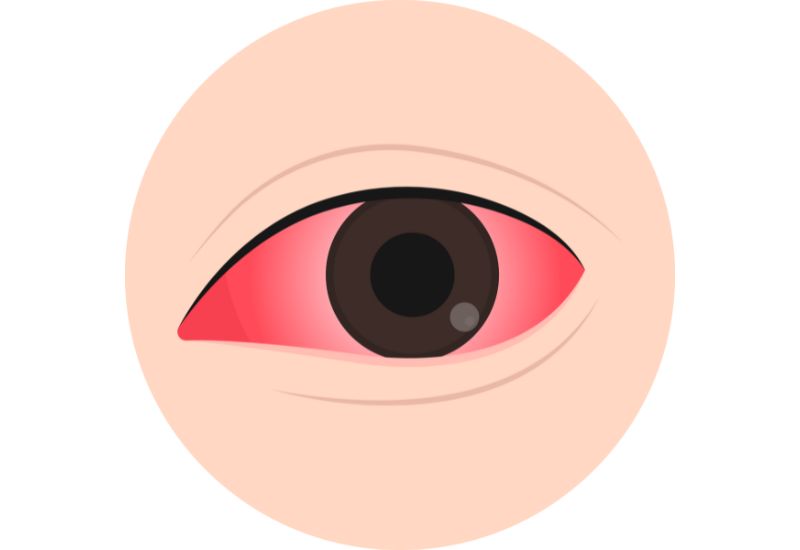Pink eye (conjunctivitis) is a prevalent condition affecting millions annually. Although it can be uncomfortable, proper treatment can make it manageable. In this article, we will explore in detail the symptoms of pink eye and effective treatment methods to help you understand and manage this condition better.
1. Detailed Symptoms of Pink Eye
Understanding what pink eye is before diving into its symptoms is crucial. Pink eye occurs when the conjunctiva, the thin transparent membrane covering the white part of the eyeball and the inner eyelids, becomes inflamed. This inflammation can be caused by infections (viral or bacterial), allergies, or irritation from environmental factors.
There are three types of pink eye:
– Viral Pink Eye: Highly contagious and spreads rapidly in communities.
– Bacterial Pink Eye: Caused by bacteria, often accompanied by severe symptoms that require prompt medical treatment to prevent complications.
– Allergic Pink Eye: Triggered by allergens such as pollen, pet dander, or dust. This type often recurs seasonally.

Pink eye can be caused by infections (viral or bacterial).
Early recognition of symptoms is key to timely treatment and limiting the spread of pink eye. Here are the symptoms to watch for:
1.1. Red Eyes
One of the most noticeable signs of pink eye is redness or pinkness in the whites of the eyes. This can affect one or both eyes. The degree of redness can vary depending on the cause, but it is usually prominent. This symptom arises due to the inflammation and dilation of the blood vessels in the conjunctiva.

One of the most noticeable signs of pink eye is the redness or pinkness of the whites of the eyes.
1.2. Other Symptoms Beyond Redness
– Swelling: Inflammation can cause swelling, making the eyes appear puffy.
– Foreign Body Sensation: Many patients report feeling as if there is sand or grit in their eyes.
– Itching: This is particularly common in allergic conjunctivitis and can be very bothersome.
– Discharge: Affected eyes may produce clear, white, yellow, or greenish discharge. In bacterial conjunctivitis, the discharge can be thick and copious, causing the eyelids to stick together upon waking.
– Tearing: Pink eye often leads to increased tear production as the body attempts to cleanse and protect the eyes.
– Light Sensitivity: This symptom is common in severe cases, where the eyes become sensitive to light.
2. Treatment Guidelines for Pink Eye
While pink eye is generally not severe, untreated cases can lead to complications affecting vision, such as keratitis, an inflammation of the cornea. This can result in partial or complete vision loss if the virus or bacteria spread from the conjunctiva to the cornea. Recurrent allergic conjunctivitis can lead to chronic inflammation of the tissues surrounding the eyes.
To avoid these complications, it is important to consult a doctor for an early diagnosis and appropriate treatment. Treatment depends mainly on the cause:
– Viral Pink Eye: There is no specific antiviral treatment for viral conjunctivitis; most cases resolve on their own within 1-2 weeks. To alleviate symptoms, you can apply a cool, damp cloth to the eyes several times a day.
– Bacterial Pink Eye: Treatment requires antibiotic eye drops or ointments, which should be prescribed by a doctor.
– Allergic Pink Eye: Treatment involves avoiding known allergens and may include antihistamine, vasoconstrictor, or anti-inflammatory eye drops.

Treating bacterial pink eye requires antibiotic eye drops or ointments.
Maintaining eye hygiene is the foremost and most crucial aspect of treating pink eye. Patients should use 0.9% saline solution to clean their eyes before bedtime and upon waking.
If pink eye symptoms do not improve or worsen after a few days of home treatment, patients should see a doctor to adjust their treatment plan and avoid unwanted complications.
Early recognition and understanding of pink eye symptoms can help you manage the condition effectively. Preventing pink eye involves maintaining good hygiene practices:
– Wash hands frequently with soap and water.
– Avoid touching or rubbing your eyes with unclean hands.
– Do not share towels, bed linens, or eye makeup.
– For allergic conjunctivitis, avoid allergens and use air purifiers to reduce allergens in your home.
By following these guidelines, you can ensure you properly care for pink eye patients and help them recover quickly. At Thu Cuc TCI, our experienced ophthalmology specialists utilize modern medical equipment to diagnose and treat pink eye and other eye conditions. Contact us today to schedule an appointment and take advantage of our excellent offers!
With this information, you can manage and overcome the discomfort of pink eye. Thu Cuc TCI wishes you healthy and beautiful eyes.








